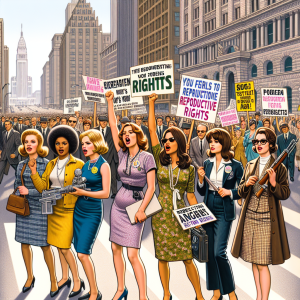#FutureGirls
Introduction
The 1960s emerged as a pivotal era for women’s activism within the United States, defining a period where the feminist movement gained momentum alongside seminal publications that challenged conventional female roles. “The Feminine Mystique” by Betty Friedan stood at the forefront of this shift, igniting discussions that would propel the women’s liberation movement forward. This narrative outlines the evolution from addressing the unnamed problem to accomplishing key feminist achievements, underscoring the persistent fight for gender equality and rights. This piece aims to trace the origins and pivotal moments of the 1960s women’s liberation movement, spotlighting the impactful role of feminist literature and activism on societal evolution.
The Dawn of Discontent: Unveiling the Feminine Mystique
Betty Friedan’s pivotal 1963 work, “The Feminine Mystique,” shattered the illusion of suburban contentment, revealing widespread dissatisfaction among American women. Friedan voiced the frustrations of countless housewives confined to domestic roles, challenging the prevailing notion that womanhood’s pinnacle was found in marriage and motherhood. This groundbreaking book motivated women to challenge and move beyond the confines of their assigned roles.
“It is easier to live through someone else than to become complete yourself.” – Betty Friedan
Sparks of Activism: The Formation of NOW
The debates stirred by “The Feminine Mystique” led to the creation of the National Organization for Women (NOW) in 1966, a cornerstone entity pushing for gender equality across various sectors, including the workplace, academia, and the legal sphere. NOW pursued a far-reaching agenda advocating for equal employment, reproductive rights, and the Equal Rights Amendment (ERA).
The Pill: A Gateway to Sexual Freedom
A significant stride in the 1960s was the approval of the contraceptive pill, granting women unprecedented control over their reproductive rights and sparking a sexual revolution. This control allowed women the freedom to invest in higher education and career ambitions, challenging the perpetual dependence on men and traditional gender expectations.
The Rise of Radical Feminism
The movement’s evolution introduced radical feminism, emphasizing the need to dismantle systemic structures sustaining women’s oppression. Groups such as the Redstockings and the Women’s International Terrorist Conspiracy from Hell (W.I.T.C.H.) garnered attention with their audacious protests, advocating for radical societal transformation to establish genuine gender equality.
“The personal is political.” – Carol Hanisch
This mantra reflected the radical feminist view, linking personal experiences with broader socio-political frameworks.
Milestones of the Movement
Feminist efforts throughout the 1960s culminated in several monumental achievements for women’s rights:
– The Civil Rights Act of 1964 included Title VII, outlawing sex-based employment discrimination.
– The formation of the Women’s Liberation group, critical in organizing protests for women’s rights.
– The Supreme Court’s Griswold v. Connecticut decision in 1965, setting a precedent for privacy rights that would influence Roe v. Wade.
Challenges Along the Way
However, the feminist movement encountered substantial opposition, with stereotypes branding activists as extreme or anti-family. Internal disagreements over strategies and goals further underlined the movement’s diversity.
The Legacy Continues
The 1960s laid a foundation for subsequent feminists, initiating crucial dialogues on gender equality that permeate social, political, and economic realms. Despite obstacles, the enduring determination of activists from this era serves as a lasting source of inspiration.
“The fight for gender equality is not a narrative of the past, but a continuous battle that grows with every voice that dares to speak out. The legacy of the 1960s women’s liberation movement teaches us that change, while often slow, is indeed possible through collective action and persistence.” – #Nada_Alahdal @nadalahdal
Conclusion
From the critical revelations with “The Feminine Mystique” to foundational achievements in feminist activism and substantial legal and sociocultural milestones, the 1960s women’s liberation movement represents a defining period in the pursuit of gender equality. This era saw a transformation from embracing predefined roles to questioning and dismantling the societal frameworks limiting women’s possibilities. The dialogue initiated by Betty Friedan, the mobilization led by entities like NOW, and the unyielding voices of radical feminism collectively contributed to the significant shifts of the time. As we progress, it is vital to celebrate and remember the legacy left by those who forged paths toward equality, acknowledging that every stride towards parity builds upon the efforts and triumphs of predecessors.
#NadaFoundation
#NadaAlahdal
#Nada_Foundation
#Feminine #Mystique #Feminist #Milestones #Tracing #Roots #1960s #Womens #Liberation #Movement
feminine-mystique-to-feminist-milestones-tracing-the-roots-of-the-1960s-womens-liberation-movement






















